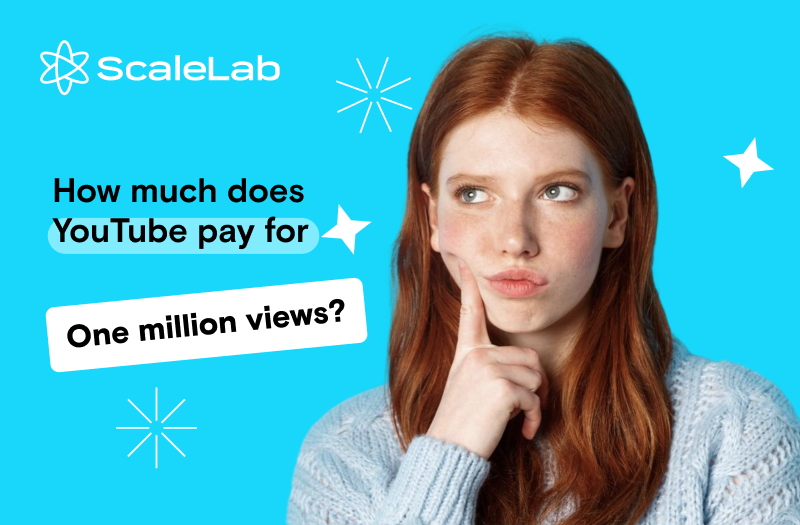Reaching success on YouTube isn’t an easy feat. More so when you don’t know what you’re getting yourself into and how much money you will gain at the end of the road. So how much does YouTube pay for a million views? Well, the answer isn’t as simple as a definite number.
1 Million Views: The Average
A lot of creators expect to break a bank after their first million views. Well, the truth of the matter is that YouTube doesn’t pay as much as you’d expect for such a milestone.
As the Influencer Marketing Hub reported, YouTubers can earn anywhere from $1 000 and all the way to $18 000 per million views on ads alone.
However, keep in mind that the number you can earn depends on a number of variables: the size of your audience, where they’re from, your niche. It could size down a whole lot more, because what YouTube pays for is not just views, it’s how many people watch the ads inside it.
Therefore, it all comes down to a simple formula: nobody views the ads in your video, you get no revenue. Which is exactly why the ads inside the video need to be placed strategically.
Want to learn how to optimize the ads in your videos?
Contact us, and we will help you improve your ads with automated tools.
What YouTube Pays Attention to
Views are only one part of the equation when it comes to revenue. The payment you receive from YouTube, again, depends on loads of variables: viewer location, how much they stick around, how many clicks, ad type. So let’s break down the most important stuff:
Ad Formats
This is one of the most important things that can seriously affect your revenue in the end.
Skippable Ads
This one is probably familiar to most. A simple “skip in X seconds”. For the viewer it’s a blessing, because they can skip and watch the rest of the video in peace. For the creator, it’s also a blessing, the main ad format most creators are betting at, which, to its credit, offers a solid, steady stream of revenue.
Non-skippable Ads
While these ads get you extra pay, they are also quite annoying for the viewer, who has to sit through the whole thing. More cash in your pocket? Yes, but less viewer-friendly.

Bumper Ads
These ads last about 6 seconds. They aren’t skippable, but to their credit they end before the viewer can get really annoyed. Bumper ads don’t get you a lot in terms of revenue, but they’re quick and the cash from these can add up over time.
Display Ads
Limited to the desktops, these ads aren’t getting in the way of the video much. Again, these don’t pay that much but they can add up (bonus points because they don’t spoil the viewer’s experience)
Overlay Ads
Another desktop exclusive, these slide across the bottom of the video. They aren’t going to break a bank for you, but, just like some of the more low-key ads, they do add up over time.
YouTube Shorts Ads
Yes, Shorts can be monetized (that was a thing for a while now). Ads can sneak in-between videos, which cannot be compared to the money longer videos make, but these can still add up to a bigger number overall.
Cost Per 1 000 Impressions (CPM) Rates
Now this is where the numbers rack up to something serious. This is what the advertisers are in general willing to pay for every thousand views on your videos. The number can vary greatly depending on a number of factors, but on average the rates go everywhere between $1 to $20. Most creators usually end up falling into the $3-$5 range.
Well, that is true unless you’re in high-paying niches such as business, everything connected to finance or tech. The average on those niches can skyrocket to $15. At the same time, creators who found themselves delving into entertainment niches (lifestyle, gaming, etc.) tend to see lower rates on their CPM.
As you can see, the number is highly dynamic, it’s not set in stone. Additionally, they can depend on a season (notice how in December the numbers grow, while dropping a lot the following month).
RPM: What You Really Get
Another thing you should be aware of is RPM (which is revenue per 1 000 views). While CPM is what you are paid by advertisers for 1 000 ad impressions, RPM is what you earn per 1 000 total views (ads, Super Chats, Premium and so much more).

Where Your Views Come From
Location matters on YouTube. Most often you might find that the advertisers are willing to pay more if you target viewers in high-income countries, which can explain why creators with vast audiences in these regions can sometimes get $10+ per 1 000 CPM.
At the same time, if your views come mostly from lower-income regions countries, your CPM could drop below a dollar. Therefore, going global is a smart strategy if you want to earn more.
Want to get higher CPM?
We can get your content seen in new regions with our professional dubbing and localization services. Reach out for a consultation.
How Old is Your Audience
Among other things that count: age. Attributes that count can also include income level, gender, and what your audience is the most interested in. For example, if your viewership falls into the ‘sweet spot’ of being mostly 25-44-year-olds, you’re in luck, because this means higher CPMs. If your audience is business owners, or otherwise ‘people with money’, advertisers will pay you more to get their products in front of your audience.
It goes without saying that what advertisers truly want is the right views. And the closer your viewership aligns with what their target market is, the more you earn.
What Your Videos Are About
In other words: what’s your niche? Some (finance, tech, business) get paid more than others (entertainment), which is understandable, because advertisers in these spaces tend to have bigger budgets and higher-value products to promote. That way, the ‘premium’ niches can get $10 and sometimes even more than $20 per 1 000 views.
What About YouTube Shorts?
The difference between YouTube Shorts and the regular ones is pretty shocking. While traditional long-form, depending on many variables discussed earlier, can earn up to $10 000+ per million, Shorts get a cut roughly between $50 to $100 per same number (with some top performers earning $200-$300).
The good news is that CPM on Shorts grows and will keep on growing (as we saw over the past year). It’s a long way from the regular video, but the trend in itself shows a possibility of a positive change.
And while Shorts are getting there in terms of revenue, they can help you grow your main channel, because it’s easier to reach with YouTube Shorts.

Which Tools Can Help?
Whichever way your content goes, whether you earn a lot from a million views or not-so-much, there are tools that can help solve a lot of the financial problems that can appear throughout your career. Of course, we are talking about the MilX App.
YouTube (usually) pays their creator at the end of the next month. With MilX, you can:
- Get paid any day
- Access up to six months of your revenue upfront
- Transfer funds using 10+ payment methods in over 40 currencies, including crypto
- All these, with the lowest money transfer fees on the market
If you want to get to 1 million views faster, we have over 30 tools and a team that knows YouTube inside out. Contact us and let’s figure out the best strategy for your channel.
